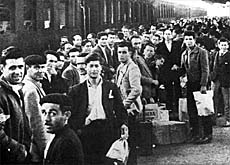
Italian immigrants shaped modern Switzerland

No other immigrants have made such a mark on Switzerland as the Italians, since they first arrived in the 1870s, according to a new book.
Entitled “A century of Italians in Switzerland”, the book documents 100 years of Latin presence and influence in the alpine nation.
Although many Italians arrived in 1870 to help build the Gotthard Tunnel, fellow countrymen had begun making their way across the border much earlier.
In addition to the Italian writers Giuseppe Mazzini and Ugo Foscolo, who arrived in Switzerland in the early 1800s, there were other migrants, such as Protestant refugees from Lucca and Veltlin, who settled in Zurich and Geneva.
But the construction of the Gotthard Tunnel opened a new chapter in relations between the Swiss and their southern neighbours, as thousands of construction workers travelled north to find work.
The construction of the tunnel from 1872-82 saw the start of a mass immigration, which peaked in the 1960s.
Five million Italians
Between the 1870s and the 1980s more than five million Italians emigrated to Switzerland; however, the population has now shrunk to 315,000, and the figure is still falling.
Italians no longer make up the largest immigrant group, having been overtaken by people from the former Yugoslavia who now number around 350,000.
“The Italian diaspora has shrunk significantly, but it has left its mark on Swiss society,” writes publisher Ernst Halter in the book’s introduction.
The book’s 30-odd authors share Halter’s view. They claim the Italians have not only left a lasting impression on everyday life, but that Switzerland’s recent history would not have been the same without their influence.
The authors, half of whom are Italian, trace a journey that runs from the bottom of the Italian “boot” all the way to Switzerland, examining the historic, political and social aspects of the migration.
Poor man’s cuisine
One example of their influence is “poor man’s cuisine” – pasta, olive oil and vegetables – which changed the traditional Swiss way of dining. Music and fashion are two other areas where the Italian influence can be seen.
Italians living in Italy often refer to their compatriots in Switzerland as “Svizzerotti” – a term used to describe their perfectionism and their tendency to complain about Italian bureaucracy.
The book also looks at the difficulty of crossing between the two worlds. Adjusting to the different way of life in Switzerland often led to psychological stress for immigrants torn between the old and the new.
The book also discusses relations between the two neighbours, especially in the difficult period after the Second World War. The Swiss tended to look down their noses at the Italians, especially the ones from the south, who they dubbed “lazy villains”.
This hostility reached its peak in the 1970s, when the Swiss launched proposals to limit the number of foreigners.
However, Switzerland’s relationship with Italy is now considered a model for successful co-existence.
swissinfo, Andrea Tognina and agencies (translation: Billi Bierling)
In the early 1870s, the first wave of Italians arrived in Switzerland to work on the Gotthard Tunnel.
Between then and the late 1980s about five million Italians lived and worked in Switzerland.
About 315,000 Italians have remained in the country – but the number is falling.

In compliance with the JTI standards
More: SWI swissinfo.ch certified by the Journalism Trust Initiative





























You can find an overview of ongoing debates with our journalists here . Please join us!
If you want to start a conversation about a topic raised in this article or want to report factual errors, email us at english@swissinfo.ch.